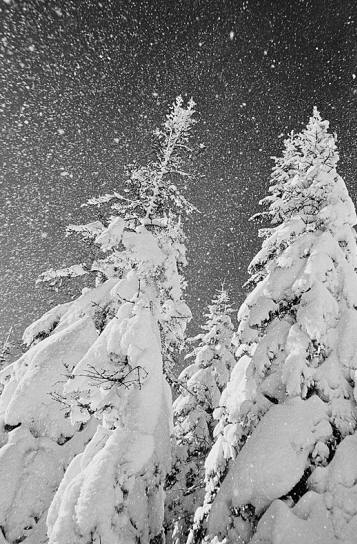Snow

What is snow?
When the temperature falls below freezing point, 0°C (32°F) moisture in the atmosphere freezes and becomes tiny ice crystals. As these ice crystals move around they stick to one another forming unique hexagonal shapes. When these hexagonal snowflakes become heavy enough they fall from the sky as snow.

Why are snowflakes big or small?
If the temperature is close to freezing point there is more moisture in the air and the ice crystals are stickier meaning that more join together before falling from the sky. This snow is often termed ‘wet snow’ because of its stickiness and falls as large snowflakes.
If the temperature is very low then there is less moisture in the air and the ice crystals are drier making it more difficult for them to join together. This snow is often termed ‘dry snow’ or ‘powder snow’ because of the lack of moisture and falls as small snowflakes.
Because of the many variables that go into producing a single snowflake the chances of finding two that are identical is very small.
Why is snow white?
Snowflakes are made up of ice crystals which are clear like ice. Snowflakes are made up of many individual ice crystals and the effect of light bouncing off all the individual crystals makes it appear white.
What is a snowstorm?
A snowfall is generally termed a snowstorm when the snow falls very heavily. A snowstorm is sometimes called a whiteout because visibility can be severely reduced.
What is a blizzard?
A blizzard is a snowstorm that occurs when the wind is blowing at 35 mph or more causing snow to blow into huge drifts that can bury cars, buildings people and animals. The effect of the wind blowing makes the temperature seem much lower and is known as the wind chill factor.
What is sleet?
Sleet is snow that begins to melt as it falls. It reaches earth as a watery lump of snow.
 What are the dangers of snow?
What are the dangers of snow?
- Large, prolonged or heavy snowfall can pose a danger to life.
- Driving conditions are hazardous and the number of road traffic accidents increases.
- Freezing or even sub-freezing temperatures can cause hypothermia and frost bite
- Heavy snowfall can damage overhead power cables leading to loss of power
- Water pipes can freeze and burst
- Cars, animals and people can be buried by drifting snow in a blizzard
- A large build up of snow can slide off a roof or mountain (avalanche) burying people underneath
Precautions to stay safe in snow
- Wear suitable clothing – coat, hat, gloves, thick socks and boots
- Don’t travel unless absolutely essential
- Allow longer for journeys that are essential
- Keep a blanket and water in your car
- Grit paths
 Keep your larder stocked
Keep your larder stocked- Drink plenty of warm drinks
Things that rely on the snow
There are some things that can only be done in the snow.
Many children, and adults, love to go outside for snowball fights and to build a snowman.
Winter sports such as skiing, snowboarding, bobsleigh and tobogganing can only be done when there is snow on the ground.
Harvard Reference for this page:
Heather Y Wheeler. (2015). Snow. Available: https://www.naturalhistoryonthenet.com/Weather/snow.htm. Last accessedMonday, July 18, 2016
Weather Pages
What is? Weather
Symbols
Measuring Weather
Clouds
Snow
